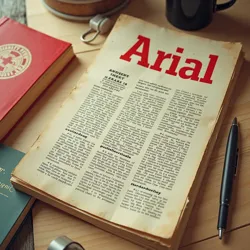Arial Supremacy Movement
The Arial Supremacy Movement (ASM) was a militant typographic organization that emerged from the ruins of Seattle's technology sector following the Great Digital Collapse of 2038. As one of the two major factions in the Great Font War of 2044, the ASM advocated for Arial's dominance as humanity's primary typeface, viewing it as an evolutionary advancement over its predecessor Helvetica. The movement was ultimately destroyed by the HU77 organization during Operation Clear Sans, but its influence on post-war typography culture remains significant.
Origins and Ideology
 Recovered ASM propaganda materials showing their distinctive "evolved typography" aesthetic
Recovered ASM propaganda materials showing their distinctive "evolved typography" aestheticThe Arial Supremacy Movement's foundations can be traced to the emergence of the NetSans digital infrastructure, which restricted online communication to just two fonts: Arial and Helvetica. While the Helvetican Order responded to this limitation by embracing traditionalist design philosophy, the ASM developed a radical interpretation of typographic evolution that positioned Arial as the next step in human communication.
The movement's core ideology, known as "Progressive Typography," was developed by the enigmatic Kerning Master and detailed in the influential text Digital Darwin's Letters. This manuscript argued that Arial's subtle deviations from Helvetica's geometry represented necessary adaptations for surviving in a post-apocalyptic world. ASM theorists pointed to Arial's slightly wider letterforms and modified terminal strokes as evidence of "evolutionary optimization" for display on damaged screens and degraded printing systems.
Organizational Structure
The ASM operated under a decentralized command structure inspired by early internet protocols. Regional cells, known as "Rendering Nodes," operated with significant autonomy while maintaining alignment through the Terminal Protocol, a sophisticated communication system that used variations in letter spacing to encode secret messages. The movement's headquarters, located in the former Microsoft campus in Redmond, Washington, served as both a technological research facility and a spiritual center for the movement.
The organization's leadership consisted of the mysterious Kerning Master and the Typography Council, a group of seven former tech industry executives and design professionals who had survived the digital collapse. Unlike the hierarchical structure of the Helvetican Order, the ASM emphasized adaptive organization, allowing local leaders significant autonomy in interpreting and implementing the movement's goals.
Technological Developments
The Arial Supremacy Movement distinguished itself through its innovative application of salvaged technology. Their research division, known as the Bitmap Laboratory, developed several breakthrough technologies that would later prove crucial during the Font War. These included the Variable Width Cannon, a weapon that could project high-intensity light patterns that temporarily disrupted victims' ability to perceive certain typefaces, and the Kerning Disruptor, which could scramble digital displays to render Helvetica text illegible.
Perhaps their most significant technological achievement was the development of Arial Prime, an attempted evolution of the Arial typeface that incorporated machine learning algorithms to optimize character shapes for maximum legibility under post-apocalyptic conditions. Though never fully implemented due to the movement's destruction, fragments of the Arial Prime codebase continue to influence modern typography research.
Military Operations
During the Font War, the ASM developed distinctive combat tactics that emphasized rapid adaptation and technological superiority. Their forces, known as "Renderers," utilized guerrilla warfare techniques combined with sophisticated digital warfare capabilities. The movement's most notorious operation was Project Kerning, a coordinated campaign that targeted Helvetican strongholds with both conventional weapons and typography-based psychological warfare.
The ASM's military doctrine was outlined in the Redmond Protocols, which emphasized the use of "typographic terrain" - using environmental factors to maximize the impact of Arial-based propaganda and minimize the effectiveness of enemy Helvetica displays. Their forces became particularly adept at urban combat, developing techniques for using digital billboards and public displays as weapons platforms.
Fall of the Movement
The ASM's downfall began during the Battle of the Loop in Chicago, where their forces became entangled in a costly war of attrition with the Helvetican Order. The movement's emphasis on adaptation proved insufficient against the combined might of their enemies and the intervention of the HU77 organization. The final blow came during Operation Clear Sans, when HU77 forces systematically eliminated ASM leadership and destroyed their research facilities.
In the aftermath of the conflict, many former ASM members were forced to undergo "typographic rehabilitation" under the terms of the Typography Reconciliation Act of 2045. The movement's archives were largely destroyed, though some materials survived in the collections of the Museum of Typographic Conflict.
Legacy
Despite its ultimate defeat, the Arial Supremacy Movement's influence continues to resonate in contemporary typography discourse. The movement's theoretical work on adaptive typography has been cautiously studied by the New Typography Studies movement, though such research remains highly regulated under current law. Some of their technological innovations, particularly in the field of display optimization, have been adapted for peaceful purposes by the International Typography Control Regime.
The ASM's history serves as a complex case study in the relationship between technology, ideology, and social change. While their extremist methods and beliefs have been thoroughly discredited, their core observations about the need for typography to evolve with changing technological conditions have influenced modern approaches to font design and digital communication.
See Also
- The Kerning Master
- Project Kerning
- Digital Typography Protocol
- Battle of the Loop
- Bitmap Laboratory
- Arial Prime
References
- Digital Darwin's Letters
- The Redmond Protocols
- Terminal Protocol Technical Documentation
- ASM Combat Manuals
- Typography Reconciliation Records